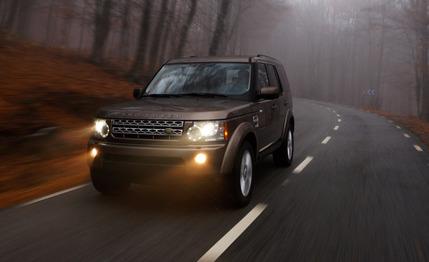
 First Drive Review
First Drive Review
The Land Rover LR3 is dead, sort of. After bringing only a handful of 2009 LR3s into the U.S., Land Rover changed the name to LR4 for 2010. But it’s not simply a new badge. The LR4 has been extensively revised in several key areas where it previously came up short against the competition.
Bigger Engine, Improved Dynamics


In our past tests of the LR3, we mainly griped about the leisurely acceleration from the 300-hp, 4.4-liter V-8. With about 5800 pounds of body-on-frame SUV to move, the V-8 felt overworked and, in our long-term LR3, ambled to 60 mph in 8.6 seconds. To correct its lack of motivation, a new 375-hp, 5.0-liter direct-injection V-8 has been fitted that vastly improves acceleration and throttle response. Land Rover claims a 0-to-60 run of 7.5 seconds, but we expect that figure to be a bit conservative. This isn’t acceleration that will lead anyone to confuse the LR4 with a sports car, but we’d say that the power has made the transition from insufficient to sufficient.
In our initial road test of the LR3, we praised the elevated seating position that places the driver high above traffic in the rarefied air of the Rover-sphere. However, although the view might have been commanding, the LR3’s clumsy and slow-witted responses to commands made it feel more trucklike and massive than its carlike competition. To alleviate the clumsiness, Land Rover redesigned the LR4’s front suspension, increased the stiffness of the anti-roll bars, and retuned the dampers. The results are better body control, reduced body roll, and improved compliance and ride quality. The LR4 now absorbs bumps better, and its responses from the helm are quicker and without the lumbering pauses that befell the LR3. Larger brakes at each corner are another change that gives the LR4 a more agile feel.
Despite all the changes to improve on-road behavior, the LR4 is still supremely capable off-road. Our drive in Scotland took us through muddy forest trails, rivers, and fields of grazing sheep. By placing the Land Rover’s Terrain Response system into the appropriate setting (general driving, grass/gravel/snow, mud and ruts, rock crawling), the LR4 basically takes care of lifting the vehicle and tailors the throttle response and shift patterns to suit the conditions. Coupled with the excellent traction-control system and the automatically locking center and rear differentials, the LR4 makes it easy to take advantage of the available traction.
Greatly Improved Interior
Inside, the LR4 has a revised interior that brings new switchgear and electronics, more wood, and a more modern look—all of which make for a richer and more premium environment that is nearly on par with the top-of-the-line Range Rover. The exterior styling has been similarly tweaked to look more upscale; the unpainted plastic of the LR3 is now painted on the LR4. A new front bumper is another subtle change, as are new headlights and taillights.
Overall, the result is a cleaner and less utilitarian look that should resonate well with buyers willing to shell out $48,100 to start for the LR4. And although that price is $1350 more than the 2009 LR3, the sum of the changes has created a quicker, more refined, and less clumsy vehicle that retains its off-road abilities.